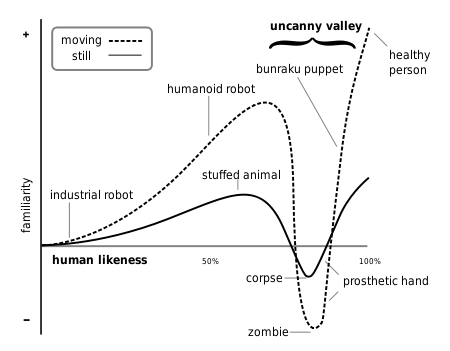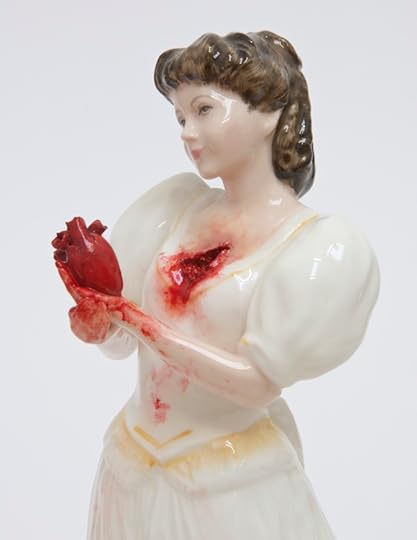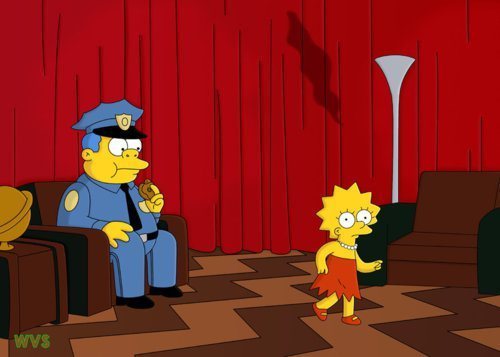Eileen Maksym's Blog, page 20
March 23, 2015
What photographs freak you out?

I’ve seen this photograph floating around the web for some time. Supposedly it’s a World War II soldier who is suffering from shell shock. His expression of utter insanity freaks me the heck out. So I was wondering, dear reader: what photographs freak you the heck out? Maybe there’s this one picture of a ghost that you can’t rationalize. Or of a person minutes before they’re the victim of a terrible tragedy. Share them in the comments! Leave a link, a description, and why this image in particular gives you the heebie jeebies. Let’s see if we can put together a collection of photographs that will keep us up all night.
[Note: Please don’t post pornographic or overly gory images. I’m screening all comments; any comments I deem inappropriate will be deleted before they ever reach the post and the poster banned.]

November 21, 2014
Ever get caught up in a good book?
November 11, 2014
Exploring the Uncanny Valley Between the Peaks
[Note: This is an expansion of an earlier post, and part of The Twin Peaks Project. Go check out the site! There's tons of awesome stuff for Twin Peaks enthusiasts and novices alike.]

I missed Twin Peaks when it first aired. On one hand, I was 12 at the time, so all the implied kinky sex, more-than-implied violence, and backward-talking dwarfs may have been too much for my young, vulnerable mind. On the other hand, my parents let me watch The Shining when I was five, so my mind was already pretty twisty, and the intense scenes in Twin Peaks are not that bad in comparison. I didn’t need to watch the show to become familiar with the basic idea and iconic images, though, mostly because everyone and their mother parodied it.
There are benefits to watching Twin Peaks for the first time via the magic of Netflix. As an adult I’m better able to deal with the scene in episode 8 where Audrey barely manages to avoid being raped by her father, or Maddy’s violent end at the hands of her possessed uncle in episode 14. More importantly, I’m better able to appreciate the divine weirdness that runs counterpoint to the scenes, that takes the world of that sleepy little town and twists it in ways that make my skin crawl (in a totally good way). What’s most intriguing is that sometimes I have the most visceral response to the scenes where the oddity is relatively minor. For example, the giant that only Cooper can see is bizarre, but the younger Hayward sisters’ dark tribute to Laura in episode 8 is much more disturbing. I think this phenomenon can be explained by comparing it to the theory of the uncanny valley.
The uncanny valley was first described in 1970 by robotics professor Masahiro Mori. Put simply, the theory is that as a robot is increasingly human-like, human empathy for it also increases. A factory robot with an arm garners more empathy than one with no discernible limbs, and a little robot with cute little eyes gets even more. There comes a point, though, where a robot is very human-like … but there’s something wrong, some relatively small detail in how it looks, how it moves, even how it sounds. At that point empathy drops sharply into repulsion.

There are tons of examples of this on YouTube, if you want to spend some time being seriously creeped out.
This effect isn’t limited to robotics. Any artificial human figure can reside in the valley. Dolls. Mannequins. Computer animated characters with jerky movements or “dead eyes.” And as you can see on the graph above, there are lots of human subjects within the uncanny valley. Corpses. Zombies. Identical twins that trigger the fear of doppelgangers.
Now, Twin Peaks has a ton of examples of this sort of uncanny valley. Everything that happens in The Black Lodge (an extradimensional location that Cooper enters twice, first in a dream and then later through a portal in the forest) is right there at the bottom: jerky movements, backwards voices, inhuman howling, doppelgangers galore, and god, the dwarf, how freaky is he? Even outside the Lodge, there are plenty of examples of humans in the uncanny valley. Audrey’s strange dangling dancing. Dale Cooper’s robotic manner, monotone delivery, and unflappable cheer. Every single damn thing about BOB.
However, I think the uncanny valley between the Peaks is wider. While the theory traditionally focuses on the appearance, movement and sound of people, our human experience is broader than that, because we also have recognition and expectations of reality in general. We accept a realistic show because we can get comfortably lost in the story. We also accept things that are just plain weird because we recognize the weird as “other,” and therefore maintain a safe distance. What really triggers unease is a more slight subversion of our expectations. These are the moments that make us blink and say, “WHAT?”
Twin Peak’s bizarre or non-sequitur details are memorable. Sometimes they’re openly (and, therefore, safely) absurd. For instance, who doesn’t remember the fish in the percolator? As bizarre as that is, the reactions of the characters take it to the next level. Cooper and Truman are disgusted, and Pete Martell is bewildered, but none of them ask the obvious question: what the heck was a fish doing in the percolator? (We know from Pete Martell’s later comment that the fish was actually alive. How did a live fish get into the percolator?)
While we are confused and amused by the fish in the percolator, it’s pretty solidly to the left of the uncanny valley. It might have gotten over the crest, but it’s not that deep into distressing territory. More effective, I think, are the details that are within the realm of possibility. They don’t have the blatant absurdity that acts as a buffer between the weird and our sensibilities. One good example of this is in the pilot; Dale Cooper and Sheriff Truman walk into the bank’s safe deposit box room and discover a deer head on the table. The explanation the attendant gives (“It fell down”) is really no explanation at all. The head doesn’t belong there, and so pushes what should be a realistic scene into surrealism, distressing us in the process.
Another purpose that the deer’s head and similar details serve is to tickle our sense of pattern recognition. Human figures in the uncanny valley disturb us in part because we as a species automatically try to make meaning out of what we see. For instance, we want to take the visual information provided by a robot and see a human being, and when there’s something that just doesn’t add up, our brains can’t process it. The deer’s head is presented as somehow significant, yet there is no significance. Many things in Twin Peaks invite us to find meaning where there is none. In episode 2 we learn of a one-armed man named Mike, companion to another man named BOB. We already know a pair of high schoolers named Mike and a Bob (or Bobby) by the time we get this information, so our brains want there to be a connection. There isn’t any, and as a result we feel deeply uneasy without necessarily knowing why.

What I find even more delightfully disturbing is how Lynch and Frost blur the line between story and storytelling. Much like objects easily identified as absurd, that boundary allows us to maintain a feeling of detached safety as spectators. Deliberately crossing that line is often very effective: consider the Netflix TV series House of Cards, where the central character Frank Underwood constantly breaks the fourth wall to hold an intimate conversation with the audience, thus making us complicit in his immoral actions. That is a clear transgression of the story/storytelling separation, but because of that clarity, we are able to accept it. We know what the rules are, even though they’ve changed. In Twin Peaks, however, the line is never entirely crossed. Cooper never turns to the camera and addresses us directly. Our world and his world remain separate.
Except when his world starts to bleed through.
The transgression is never anything as blatant as breaking the fourth wall, and yet it is more unsettling because it isn’t blatant. A lot of the bleed-through has to do with music, and since our awareness of the music is typically subconscious, we can be weirded out without quite understanding why. Movies and TV shows have two levels of music: diegetic and non-diegetic. Diegetic music occurs within the world of the story, and is audible by the characters. Non-diegetic music is external to the story, the “soundtrack” if you will, and is typically inaudible to the characters. Non-diegetic music is supposed to enhance scenes by heightening our emotions and helping us to better understand and empathize with the characters.
One way that Twin Peaks subverts our expectations is with non-diegetic music that is inappropriately jolly or sappy. For example, sweet soap opera style music accompanies Nadine’s suicide attempt in episode 7. The music suggests that the scene is attractive, even positive, when it’s actually horrifying, and the mismatch triggers cognitive dissonance.
Twin Peaks also frequently blurs the line between diegetic and non-diegetic. When Agent Cooper wakes up from his dream about the Red Room in episode 1, he starts snapping his fingers in time with the soundtrack, even though there’s no way any music is playing in his room. There are also times when the soundtrack music is actually coming from inside the story! In the second half of season two we often hear flute music as part of the soundtrack, eventually to discover that the flute is actually being played by Windom Earle.
Lynch and Frost recently announced that there will be a new Twin Peaks miniseries. I’m excited, but I’m also a little apprehensive. One of the things that made Twin Peaks great was that violin string of tension between the real and the surreal that would sing when plucked by the experiences of the uncanny. That tension started to dissipate in the second half of season two, because the weirdness that was subtext was rapidly becoming text, altering our expectations and thus our experience. It will be very interesting to see if they can restring that violin and have us all dancing, dwarf-like, to the tune of the weird.


October 31, 2014
HAPPY HALLOWEEN! Have a Paper Skull Pattern!
Click on the paper skull for a PDF on how to create it! Found at the delightful Skull-A-Day.
Happy Halloween!

October 29, 2014
Pastorally Ghoulish

Hat tip A New Hype. Click image for the original post.
Horror can often be heightened when juxtaposed with the wholesome and innocent. That’s one of the reasons why toys and children in horror movies can be particularly terrifying. That’s what makes these figurines by Jessica Harrison so disturbing. Traditionally such pastoral figures are soothing, safe. By subverting that with gore (the heart here…other images include the brain, intestines, and even the face) the corrupted image shows us that we are not safe, and that what soothed us is a mirage. Interestingly, it is at least implied that the women portrayed mutilated themselves. They are not innocent victims, but rather perverse actors. Very creepy.

October 27, 2014
Satan’s Playhouse and the Pig’s Head

From “18 Terrifying Old Costumes You Can’t Unsee” on MentalFloss.com. Click on the image to see the other 17, if you dare…
I have a knee-jerk fear reaction to realistic (or real!) pig costumes. Here’s why:
As an undergrad, I was involved with the Yale Children’s Theater as an actor, director, producer, costume designer, and probably other positions that I can’t remember right now. They did tons of productions every year for the local kids. Every Halloween, however, the group put on a haunted house that was most definitely NOT for children. Satan’s Playhouse was an opportunity for us all to shed our wholesomeness and indulge in some hardcore depravity. And oh boy, did we come up with some disturbing stuff.
The Satan’s Playhouse my freshman year had a Christmas theme. It was arranged in a series of tableaus, including a family dinner where the main course was a trussed naked woman, and a Christmas tree where the presents looked normal until lights went on inside them and revealed the cellophane boxes contained twisted, struggling and bleeding people (also naked…there was a lot of nudity…). But the most disturbing thing was the rotting Santa Claus. That image alone is disturbing, but what really got me was the pig’s head he would pull out of his sack, stick on a pike, and use to chase the spectators. It was the first and last thing the spectators saw: they were chased into and out of the house by a cackling Jolly Old Saint Nick.
What pushed that from disturbing to horrifying for me was that the pig’s head was real. They kept it in a large cooler between performances to keep it fresh, but the smell was still repulsive: raw meat, swine, an insidious whiff of decay. The rotten Santa “accidentally” touched me with the cold, slimy, bristly snout once, and after five minutes in the bathroom frantically scrubbing my skin, I spent the rest of the performances staying as far away from the guy and the horrible thing.
I think the pig’s head terrified me most because it was the one thing in the whole performance that broke the fourth wall, that could not be safely categorized as fiction. The flesh that was cut off the roasted woman and gobbled up by a ravenous family? Cold cuts. The blood that wept from the flailing half-dead human presents? Corn syrup dyed with food coloring. But that head, with its rictus grin, lolling tongue, clouded eyes? A day earlier that was a living animal that was brutally slaughtered. Its horror could not be denied. It was True.
What about you, dear readers? What sort of Halloween costume are you reflexively repulsed by, and why?

October 24, 2014
Truth Stranger Than Fiction: 136 Creepy Wikipedia Articles
They say truth is stranger than fiction, and that’s absolutely accurate. One of the great things about that is that strange truth can also inspire fiction. I’ve talked here before about writing between the lines of great unsolved mysteries. But the range of strange truth is much wider than that. This list of creepy Wikipedia pages is just stuffed full of potential story ideas. It’s also tons of fun to just read the articles for the sake of creeping yourself the heck out. What else is October for? Have fun!

October 22, 2014
Modern Pyramid: Death on the London Skyline
We use (some say waste) a lot of land for the burial of our dead. This pyramid, proposed for London in the 19th century by Thomas Willson, would be one answer. It never caught on, and I think the reason is that, while we can forget the existence of cemeteries when we’re not visiting them, this massive structure would always be visible on the city skyline.
Click the image for more information. Hat tip We Waste Time.

October 20, 2014
Less is More: Garfield Without Garfield
If you have yet to discover Garfield Minus Garfield, get thee hence.

“Garfield Minus Garfield is a site dedicated to removing Garfield from the Garfield comic strips in order to reveal the existential angst of a certain young Mr. Jon Arbuckle. It is a journey deep into the mind of an isolated young everyman as he fights a losing battle against loneliness and depression in a quiet American suburb.”

Removing the comical cat from the strip reveals an underlying desperation that, if you think about it, has always been there. Whether Jon is talking to his cat or to himself, he is still having a one-sided conversation.

If you consider other comic strips, though, it becomes clear that this isn’t at all rare. A surprising number of them are about deeply unhappy characters fighting to keep themselves afloat. Peanuts springs immediately to mind: a depressed Charlie Brown, an obsessed Lucy, an insecure Schroeder, a hygiene-challenged Pig Pen, a Snoopy that escapes into a fantasy world. We might turn the same lens toward Cathy and her struggle with age and singlehood, or The Far Side with a world where even science is steeped with absurdity and unpredictability.

Why is this so common? Maybe it has to do with that old canard, “It’s funny because it’s true.” Surely we aren’t Jon Arbuckle, are we? Look at that potato shaped head, the huge bug eyes. He can’t be us, yet paradoxically that allows him to be exactly like us, because otherwise it would be too close for comfort. We laugh because it’s ridiculous, and the ridiculousness frees us laugh because it’s true.

Take away the cat silently cracking wise, and we’re just left with Jon, who is closer to our truth. Go check out Garfield Minus Garfield. You will laugh, you will cry, you will recognize yourself.


October 17, 2014
Look At That Escargo!
Nature vs. technology, as explored by Michael Schouflikir. Click the image for more. (H/T Beautiful/Decay)













